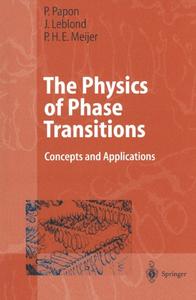The Physics of Phase Transitions: Concepts and Applications by Pierre Papon , Jacques Leblond , Paul H. E. Meijer
English | PDF (True) | 2002 | 410 Pages | ISBN : N/A | 36.1 MB
We learned in school that matter exists in three forms: solid, liquid and gas, as well as other more subtle things such as the fact that "evaporation produces cold. " The science of the states of matter was born in the 19th century. It has now grown enormously in two directions: 1) The transitions have multiplied: first between a solid and a solid, par ticularly for metallurgists. Then for magnetism, illustrated in France by Louis Neel, and ferro electricity. In addition, the extraordinary phenomenon of su perconductivity in certain metals appeared at the beginning of the 20th cen tury. And other superfluids were recognized later: helium 4, helium 3, the matter constituting atomic nuclei and neutron stars . . . There is now a real zoology of transitions, but we know how to classify them based on Landau's superb idea. 2) Our profound view of the mechanisms has evolved: in particular, the very universal properties of fluctuations near a critical point - described by Kadanoff's qualitative analysis and specified by an extraordinary theoretical tool: the renormalization group. Without exaggerating, we can say that our view of condensed matter has undergone two revolutions in the 20th century: first, the introduction of quantum physics in 1930, then the recognition of "self-similar" structures and the resulting scaling laws around 1970. .
Dear AvaxHome Users And Visitors
Thanks For Buying/Renewing Premium From My Blog Links To Support
Without You And Your Support We Can't Continue
Thanks For Buying/Renewing Premium From My Blog Links To Support
Without You And Your Support We Can't Continue



